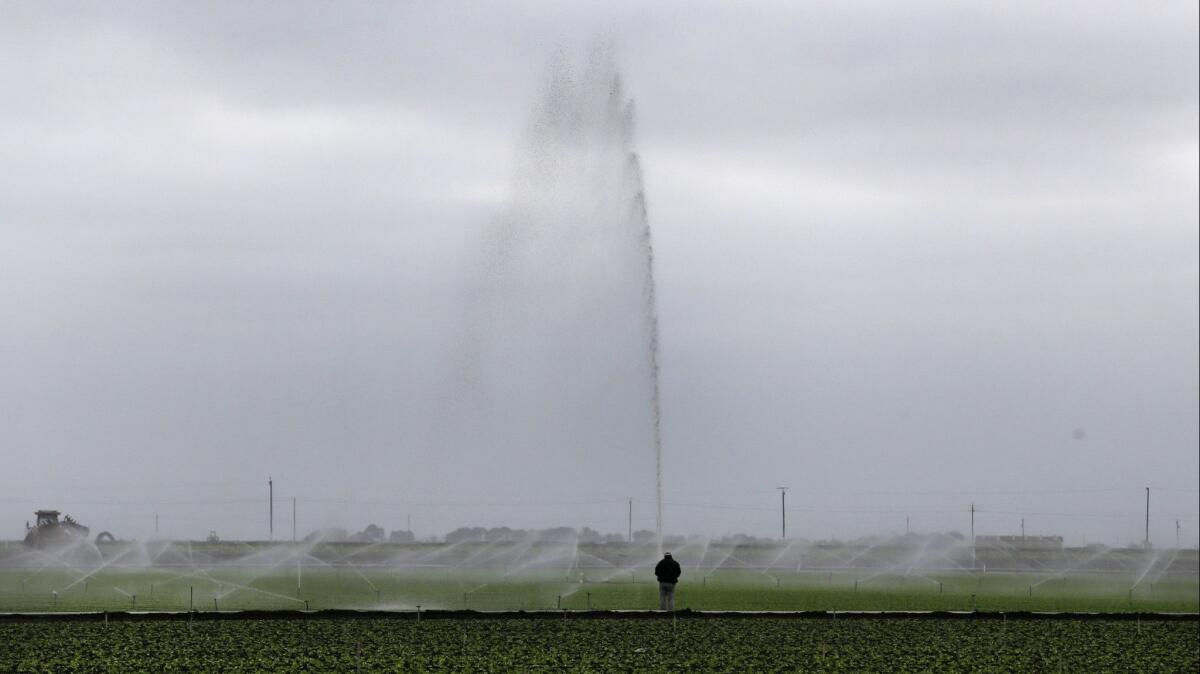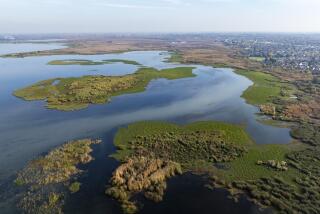Editorial: Gavin Newsom needs a plan for California’s endangered water supply

California’s water supply is now inextricably tied up with climate change. In a warming world, nature has already brought smaller Sierra snowpacks and less predictable precipitation patterns, with periods both of drought and of flooding. Gov. Gavin Newsom, if he is to successfully steer the state into the future, has to bring to his water agenda the same steely-eyed, reality-based drive that the two previous governors brought to limiting carbon emissions.
It is time for the state to respond to its water challenge with the same sense of urgency with which it adopted Assembly Bill 32, the landmark law capping greenhouse gas emissions, in 2006.
That same year, the state began a long drought that may not yet have ended, although it has been punctuated by periods of extreme wet weather. Water forms the most tangible edge of climate change.
Ground zero in the state’s water challenge is the Central Valley.
The task will be in some sense simpler than adopting AB 32, and the results could conceivably be more rewarding. Govs. Arnold Schwarzenegger and Jerry Brown, in making the state a leader in the fight against climate change, knew that they were setting an example for the rest of the world, even though reducing carbon emissions here has only an incremental effect on our own air and climate. Someone had to show the way, and they did.
Now, if Newsom recognizes the connection between a warming planet and changes to California’s hydrology, he could drive a new approach that not only sets a moral standard for a planet in which water is an increasingly contentious resource; he could also ensure that the state’s own environment and economy can survive and in fact thrive amid wrenching change. A climate-oriented water agenda accomplishes more than moral leadership. It keeps our thirst quenched, our crops growing and the priceless web of life intact.
Of course, water is more tangible than carbon emissions, and rights to it are owned, exercised and transferred, so enacting a plan for water resilience in the face of climate change will pose challenges that may make reducing carbon emissions seem easy in comparison. But we have no choice. At least, not if we want California to continue to have a sustainable environment and a vital economy.
Ground zero in the state’s water challenge is the Central Valley, the vast, flood-prone region that was tamed by 20th century engineering projects and turned into the nation’s richest agricultural region.
The changing climate and more volatile weather patterns make the valley again susceptible to flooding. Sacramento, in fact, is among the U.S. cities most vulnerable to inundation. Any water plan for California should start with protection from flooding and with projects that capture, reroute and store floodwaters.
That means a different approach from the last century’s great engineering projects. Instead of dams, California today needs projects that meet multiple needs at once: reducing flood risk, recharging depleted groundwater and restoring degraded wildlife habitat. Voters have approved a number of such projects already, but Newsom’s leadership can ensure that they are completed more quickly.
It also means stepping up the timeline of the landmark groundwater laws that finally require that subsurface water be measured, managed and equitably shared.
Enter the Fray: First takes on the news of the minute from L.A. Times Opinion »
Less groundwater will inevitably mean agriculture must become more efficient, and perhaps more geographically concentrated, with rich islands of green amid retired land. At the same time, advances in farm practices that raise productivity will also probably mean field jobs become scarcer. Newsom ought to not merely keep his eye on the San Joaquin Valley economy, but be ready with an action plan that helps it diversify beyond agriculture.
In Southern California, we have our own crops to retire: lush, green lawns that must be soaked, fertilized and carefully trimmed but that never produce anything that can be eaten, worn or sold. The long drought, and enticements from water agencies, convinced many homeowners to pull out their lawns. We must keep that retirement going. Water is too precious a commodity for such use.
Newsom also has a role in helping the region move more quickly to recapture and reuse stormwater and wastewater. He appears willing to encourage cities to build more housing — and to hold back funding to those that drag their feet. He should consider a similar system of enticements and penalties for water practices.
Follow the Opinion section on Twitter @latimesopinion and Facebook
More to Read
A cure for the common opinion
Get thought-provoking perspectives with our weekly newsletter.
You may occasionally receive promotional content from the Los Angeles Times.






